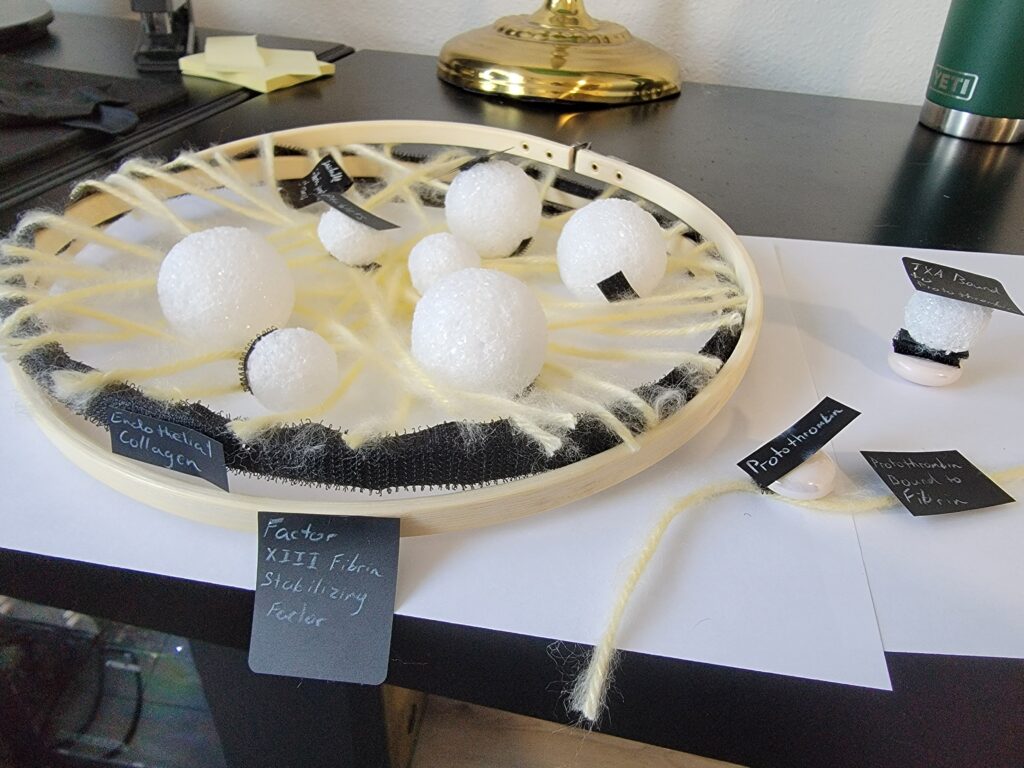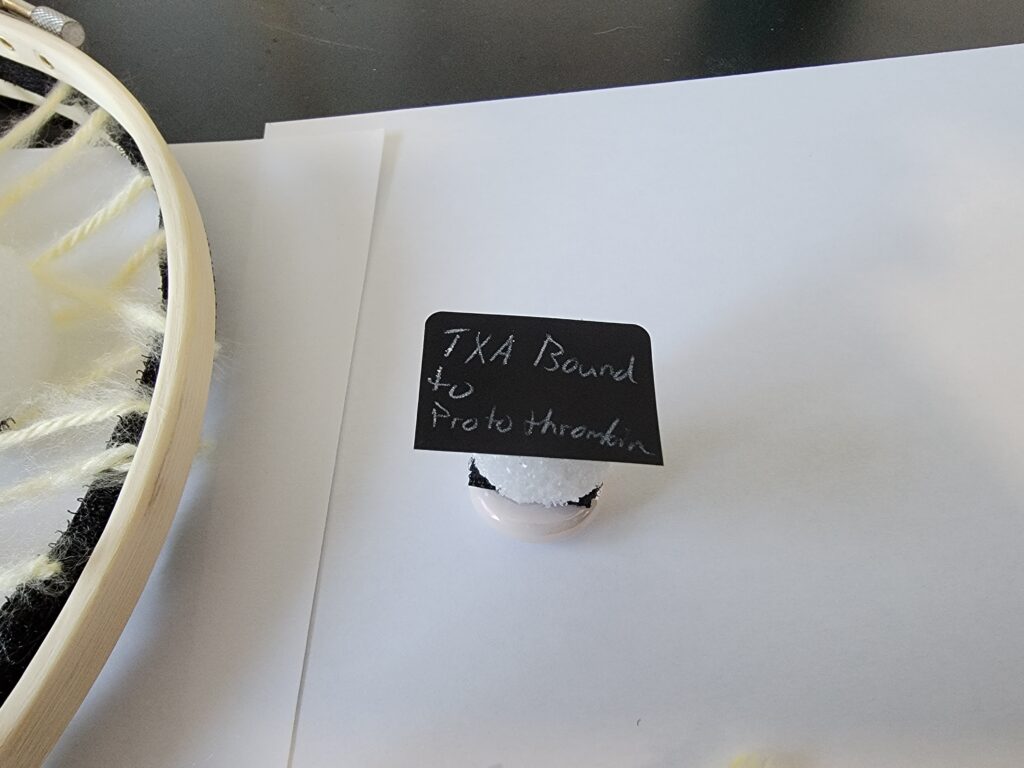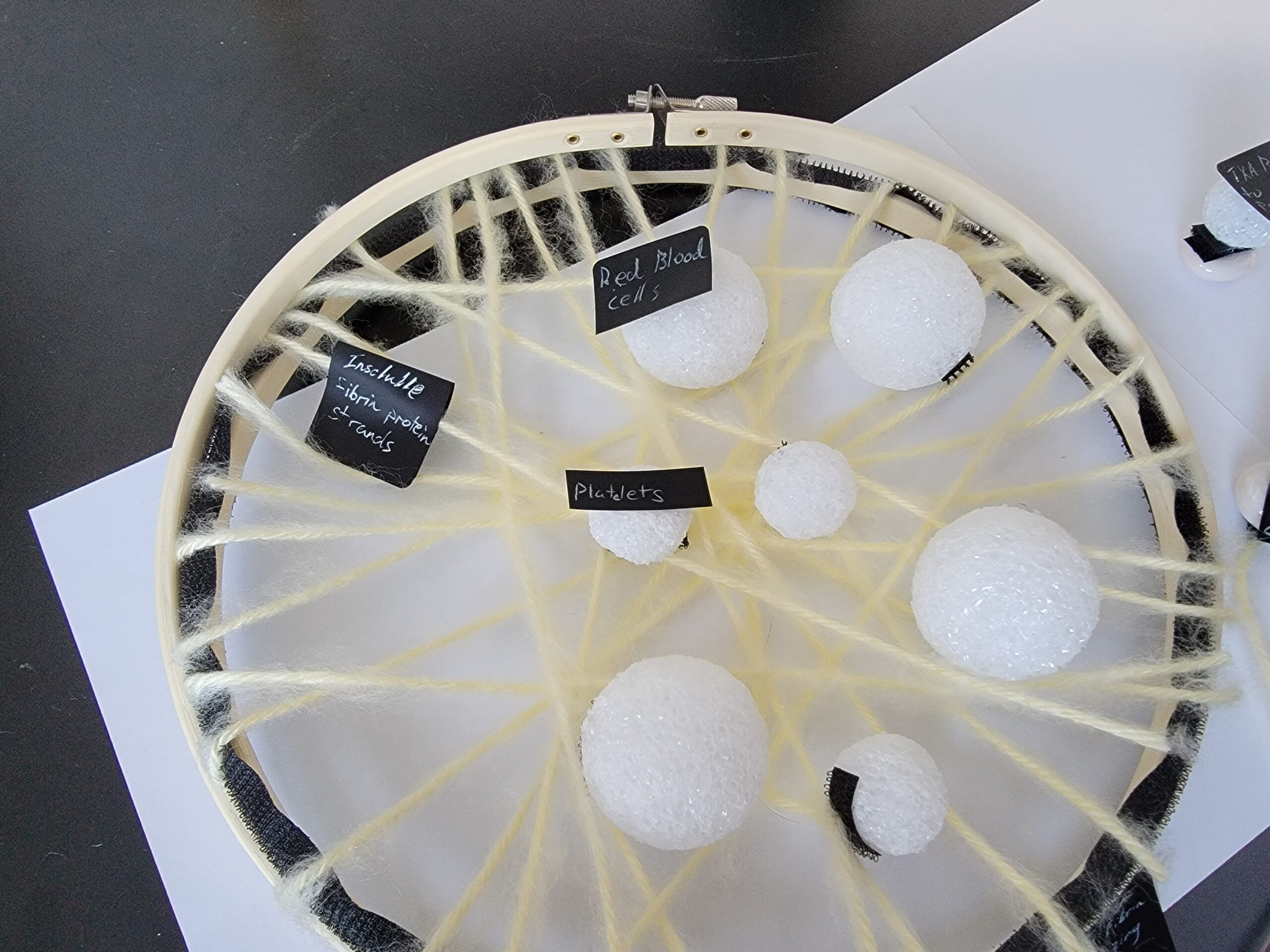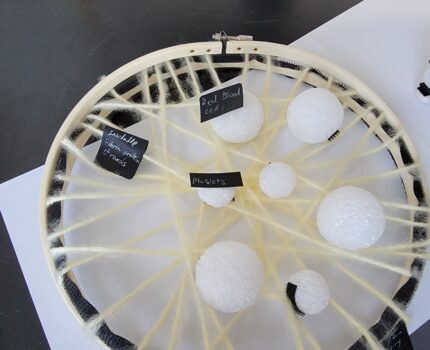The purpose of this STEAM project medium was to create an interactive snapshot representation of a clot forming and the effects of TXA on the formation of the clot. During clot formation the clotting cascade is activated and common pathway factors build the fibrin net and in turn the physical clot. TXA acts by preventing plasminogen floating free in the blood plasma from acting on activated factor I, the fibrin strands that form the fibrin net. This project is safe to handle and encouraged.



Full STEAM Project Report.
The focus of this STEAM project will be on the use, interaction, and effects of tranexamic acid, commonly referred to as TXA on patients with life threatening hemorrhage. The clotting cascade will be reviewed for context and understanding as this drug acts directly on common pathway factors. The mechanism of action and effects will then be reviewed, alongside the efficacy of the drug. Finally, a brief synopsis of the interactive STEAM project medium will be given. Specific curriculum objectives that will be utilized will include in the endocrine system; hormonal influence over other hormones and target cells, in the Immune and Lymphatic System; the functions of WBCs, and in the Cardiovascular System, the components of blood and key structures, and the function of RBC’s and hemoglobin. The entirety of this project can be understood as; Tranexamic Acid is an antifibrinolytic agent used in pre, and, in-hospital settings, to prevent mortality due to exsanguination.
For contextual understanding, the clotting cascade is as the name would suggest a cascading event triggered by rupture of the vessels of the body or trauma to tissues. This may be any vessel from capillary beds to major arteries, or any tissue structure that received blood supplies. The clotting cascade is divided into two subgroups, intrinsic pathway or clotting factors inside the vessel, and the extrinsic pathway or clotting factors outside the vessel. The intrinsic pathway is triggered by trauma to a vessel wall and the extrinsic pathway is triggered by trauma to surrounding issues. It should be noted that the clotting cascade is not numbered in order of events occurring but instead in the order that these factors were discovered, which is why the pathway seems to be disordered when explained in order of events. In the event of trauma to bodily tissues occurring, the extrinsic pathway is activated. Upon contact with blood plasma, damaged extravascular cells release factor III or thromboplastin. Following this, Ca2+ is released and then factor VII or proconvertin, these then form an enzyme complex that activates factor X, known as the Stuart-Prower factor which is thrombokinase. (This factor is both an extrinsic and intrinsic factor and the triggering of it is known as the common pathway factor as all events after this are both extrinsic and intrinsic.) The intrinsic pathway follows the same methodology though longer, more complex, and with different clotting factors. The intrinsic pathway may be activated in the event of vascular trauma; in this event blood and blood components begin to leak out of the vessel triggering the extrinsic pathway, simultaneously, the smooth muscle of the vessel will spasm causing vasoconstriction, the pathway is initiated by factor XII known as the Hageman factor and is the event of inactivated serine proteases (found in both eukaryotes and prokaryotes) being exposed to endothelial collagen, this only occurs when endothelial damage occurs. The exposure causes factor XII to become activated and known as factor XIIA, A for active. This factor then becomes a catalyst to activate factor XI, the antihemolytic factor C or plasma thromboplastin antecedent. This then triggers factor IX, the antihemolytic factor B or thromboplastin. In tandem with this, platelets from megakaryocytes release over 300 chemicals to increase the rate of factor activation, however the one most relevant to us is the protein fibrin. Finally, factor VIII, antihemolytic factor A from platelets along with endothelial cells combine to form the same enzyme complex as the extrinsic pathway to activate factor X and converge into the common pathway. In the common pathway, the enzyme prothrombinase converts factor II, prothrombin, into the active enzyme thrombin. Thrombin then converts factor I, soluble fibrinogen into insoluble fibrin protein strands. Factor XIII, consisting of plasma proteins and aptly named the Fibrin-stabilizing factor does exactly that and stabilizes the fibrin net. The binding of fibrin to platelets around the site of trauma acts as a literal net to catch and hold RBCs, platelets, and plasma proteins and forms what is referred to as a clot and seals off the site of trauma, creating an impermeable membrane that allows the restoration of normal circulation. Simply put, the clotting cascade is a series of factor changes that converge and form a fluid tight plug of blood products at the site of injury.
TXA acts in an interesting and novel way to aid in the formation of clots. As the clotting cascade is activated, plasminogen binds to the activated fibrin and causes a breakdown of fibrin. This in turn delays or breaks down the cot, known as clot dissolution. To prevent this TXA binds to the lysine binding sites of plasminogen and prevents the plasminogen from binding to the fibrin and allows the fibrin to bind to platelet factors and other fibrin strands to form the fibrin net. The end-state effect of this is the prevention of fibrinolysis as explained by Stansfield, Morris, and Jesulola in the Journal SHOCK. Induction of TXA is 1g IV in 100mL normal saline over 10 min, followed by 1g in 500mL normal saline over 8hrs. The CRASH-2 trial found that all-cause mortality at 28 days was significantly lower in patients that received TXA vs placebo (14.5% vs 16.0%). This trial shows an absolute reduction of mortality of 1.5% for trauma patients across a trial of 20,127 patients in 274 hospitals across 40 countries. Greater efficacy of TXA was correlated to earlier administration (≤ 1 hour from injury, significantly reduced the risk of death due to bleeding) Guyette et al. found in their double blinded, placebo controlled, randomized clinical trial similar findings as CRASH-2, and that there was no statistical difference of medical complications to include thrombotic complications when compared to placebo. These two trials found in the author’s own words that “Tranexamic acid given to injured patients at risk for hemorrhage in the prehospital setting is safe and associated with survival benefit in specific subgroups of patients” (Guyette et al.).
The STEAM project medium is an interactive display of a clot. Pertinent clotting factors, vascular structures, tissues, and TXA are all labelled, though colors and scale are sized for interaction not accuracy. This medium allows participants to build the clot themselves, see how it forms, and the effects of plasminogen on activated fibrin and TXA on plasminogen. As the clotting cascade is a complex subject, this will hopefully allow participants to “touch” what they have reviewed in the essay and gain a more robust understanding of how clotting in the body works.
In conclusion, TXA is an antifibrinolytic agent, used in pre, and in-hospital settings to prevent mortality due to exsanguination. It works by binding to lysine binding sites of plasminogen to prevent plasmin from binding to activated fibrin. The risk profile has been studied extensively and determined low. When administered early, TXA has been shown to reduce all-cause mortality in hemorrhagic patients.
References.
Chaudhry, R. (2022, May 6). Difference between extrinsic and intrinsic blood clotting pathways. Difference Between Similar Terms and Objects. Retrieved April 15, 2023, from http://www.differencebetween.net/science/health/difference-between-extrinsic-and-intrinsic-blood-clotting-pathways/.
Discipline, ∗P. (n.d.). The use of tranexamic acid (TXA) for the management of… : Shock. LWW. Retrieved April 15, 2023, from https://journals.lww.com/shockjournal/fulltext/2020/03000/the_use_of_tranexamic_acid__txa__for_the.4.aspx#:~:text=Tranexamic%20acid%20(TXA)%20is%20an,hemophiliacs%20undergoing%20oral%20surgical%20interventions.
Francis X. Guyette, (2021, January 1). Tranexamic acid during prehospital transport in patients at risk for hemorrhage after injury. JAMA Surgery. Retrieved April 15, 2023, from https://jamanetwork.com/journals/jamasurgery/fullarticle/2771225.
Roberts I;Shakur H;Coats T;Hunt B;Balogun E;Barnetson L;Cook L;Kawahara T;Perel P;Prieto-Merino D;Ramos M;Cairns J;Guerriero C; (n.d.). The crash-2 trial: A randomized controlled trial and economic evaluation of the effects of tranexamic acid on death, Vascular occlusive events and transfusion requirement in bleeding trauma patients. Health technology assessment (Winchester, England). Retrieved April 15, 2023, from https://pubmed.ncbi.nlm.nih.gov/23477634/#:~:text=The%20CRASH%2D2%20trial%20aimed,vascular%20occlusive%20events%20was%20assessed.
.


Tranexamic acid (TXA) has been show to be successful in treating and preventing death from blood loss. To begin it is important to explain how blood clots form, this is a complex process with both intrinsic and extrinsic factors. Then the mechanism that TXA uses can be better understood in detail. Finally a look at some of the clinical studies that have been done to observe the efficacy of TXA in pre and in hospital settings.